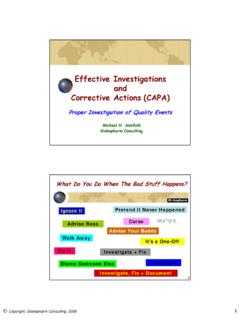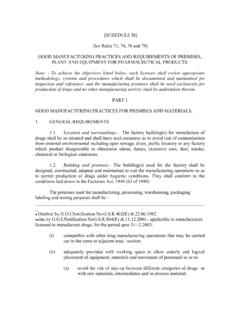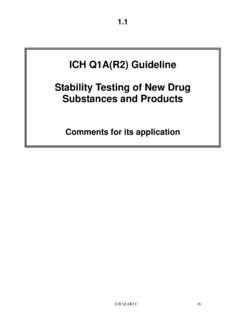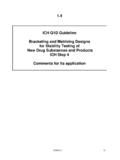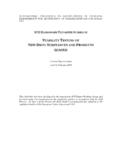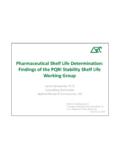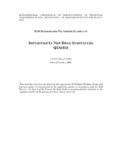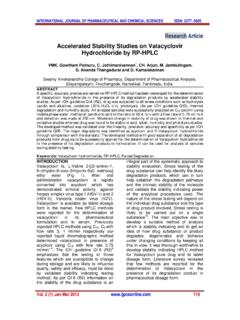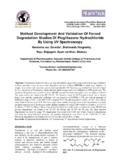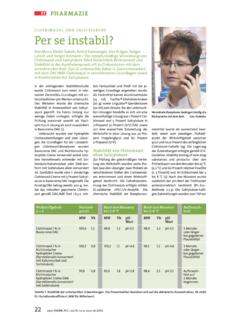Transcription of Global Long Term Stability Testing Conditions: Position of ...
1 Global long Term Stability Testing conditions : Position of INDIAS aranjit Singh, Institute of Pharmaceutical Education and Research (NIPER), SAS NagarThe towering importance of long -term Stability Test ConditionsAccording to latest guidelinesExpiry date is determined from long -Term Stability Test DataAccelerated data considered only supportiveExpiry Date Calculations from long -term Data based on 95% Confidence LimitsExpiry dateFrom where did this concept arise?US FDA Guidance of 1987 Historical Perspective of the Development of Global Storage ConditionsThe Development of Concept of Zones Major contribution: Dr Wolfgang GrimmThe zone conceptRegionZone I and II countriesZone III and IV countriesEuropeAll countries------AmericaArgentina, Bolivia, Chile, Canada, Mexico, Peru, Uruguay, USAB arbados, Belize, Brazil, Costa Rica, Dominican Republic, Ecuador, El Salvador, Guatemala, Guyana, Haita, Honduras, Jamaica, Columbia, Cuba, Nicaragua, Dutch Antilles, Panama, Paraguay, Puerto Rico, Venezuela.
2 All of these countries are assigned to CZ , Armenia, Azerbaijan, China, Georgia, Iran, Israel, Japan, Kazakstan, Kirghizia, Korea, Lebanon, Nepal, Syria, Tadzhikistan, Turkey, Turkmenia, UzbekistanBahrain, Bangladesh, Hong Kong, India, Indonesia, Iraq (III), Jordan (III), Kampuchea, Qatar, Kuwait, Laos, Malaysia, Maldive Islands, Myanmar, Oman, Pakistan, Philippines, Saudi Arabia, Singapore, Sri Lanka, Taiwan, Thailand, United Arab Emirates, Vietnam, YemenAfricaEgypt, Algeria, Tunesia, Libya, Morocco, Namibia, Ruanda, South Africa, Tunesia, Zambia, , Ethiopia, Benin, Botswana (III)
3 , Burkino Faso, Burundi, Djibouti, Ivory Coast, Gabon, Gambia, Ghana, Guinea, Cameroon, Kenya, Longo, Liberia, Madagascar, Malawi, Mali, Mauritania, Mozambique, Niger, Nigeria, Senegal, Sierra Leone, Somalia, Sudan, Tanzania, Togo, Chad (III), Uganda, Zaire, Central African , New Society Islands, Marshall Islands, New Caledonia, Papua-New Guinea, Samoa, of Zone Concept in International GuidelinesICH guidelineQ1A(1993) focused onICH Zones I and IIWHO guideline of 1996coverednon-ICH Zones III and IV, in addition to Zones I and IIICH Q1A (Zones I and II)25 20C/60 5% RHLong Term30 20C/60 5% RHIntermediate40 20C/75 5% RHAcceleratedStability StorageConditions in ICH and WHO guidelinesWHO (Zones III and IV)30 20C/35 5% RH (Zone III) long Term40 20C/75 5% RHAccelerated30 20C/70 5% RH (Zone IV)The Start of Politics on long -term Stability Storage ConditionsICH Q1A (Zones I and II)
4 25 20C/60 5% RHLong Term30 20C/60 5% RHIntermediate40 20C/75 5% RHAcceleratedThe problem for Industry in ICH regionsWHO (Zones III and IV)30 20C/35 5% RH (Zone III) long Term40 20C/75 5% RHAccelerated30 20C/70 5% RH (Zone IV)Paper by Dr Nick Turner, Rapporteur, ICH EWG Q1 StabilityCopy of paperHis pleaIntermediate storage condition in ICH guideline of 30 C/60% RH for Zones I and II was equally stressful to long -term condition of 30 C/70% RH for Zone IV in the WHO guidelineWHO accepts plea on majority recommendations by expertsObjection by African region30 C/60 5% RH30 C/55% RH - 30 C/65% RH Very dry for Very dry for Coastal AfricaCoastal AfricaRe-consideration by ICH and WHOA grand hand-shakebetween ICH and WHOICH Intermediate30 C/65% RHWHO Zone IV long -term30 C/65% RHAgain a win-win
5 Situation for industry in ICH regionsIntroduction of ICH Q1F guidanceGuideline Q1F for Zones III and IVParent drug Stability guideline considered applicable to Zones III and IV, except conditions for long -term testingLong-term : 30 C/65%RH for 12 months (also an intermediate condition for Zones I and II)Accelerated: 40 C/75% RHfor 6 monthsAdditional conditions to cover special storage requirements or shipment: 45-50 C and 25 C/80% RHQ1AQ1A(R)Q1A(R2)/Q1F25 20C / 60 5% RH25 20C / 60 5% RH25 20C/ 60 5% RHor 30 20C/65 5% RH(Decision is left to the applicant)
6 Stability StorageConditionLong Term30 20C / 60 5% RH30 20C / 60 5% RH30 20C / 65 5% RHIntermediate40 20C / 75 5% RH40 20C / 75 5% RH40 20C / 75 5% RHAcceleratedCHANGECHANGES ummary of changes in storage conditions till this point30 20C/65 5% RH30 20C/60 5% RH30 20C/70 5% RHWHO long -termCHANGEThe buck doesn t stop thereASEAN OBJECTIONSTABILITY Testing FOR HOT AND HUMID CLIMATESAN UPDATE FROM THE ASSOCIATION OF SOUTH EAST ASIAN NATIONS (ASEAN) HARMONIZATION PROCESSWe should much appreciate your feedback, your comments, on whether, in light of the attached text, the current WHO conditions for long -term Stability Testing (real-time) should be changed from 30 C ( 2 C), 65% ( 5%) RH to 75% ( 5%) RH, or back to 70% ( 5%) send comments to Dr S.
7 Kopp, Quality Assurance and Safety: Medicines, Essential Drugs and Medicines Policy, World Health Organization, 1211 Geneva 27, Switzerland, fax: (+41 22) 791 4730 WORLD HEALTH ORGANIZATIONORGANISATION MONDIALE DE LA SANTESTABILITY STUDIES IN A Global ENVIRONMENTG eneva, 13-14 December 2004 Recommendations agreed by the meetingA Revert to 30 C/70%RH as the long -term Stability Testing condition for Zone IV as it is likely that considerable data are already available. This might serve as a potential platform for future harmonization between ICH and WHO.
8 B Change to 30 C/75%RH as the long -term Stability Testing condition for Zone IV in the interest of patient safety worldwide. C Add a new climatic Zone IVb to accommodate hot and very humid areas (30 C/75% RH). The present Zone IV (30 C/65%RH) would become Zone is requested by end March 2005 at the HEALTH ORGANIZATIONORGANISATION MONDIALE DE LA 20C/60 5% RH (Zones I and II)30 20C/65 5% RH (Zones III and IVa)30 20C/75 5% RH (Zone IVb) long Term30 20C/65 5% RH (Zones I and II)Intermediate40 20C/75 5% RH (All zones)AcceleratedModified Storage ConditionsRise in Regional ExpectationsRegional guidelinesASEANEMRBRAZILMEXICOS outh AmericaPANAMACENTRAL AMERICACOSTA RICAC entral America and the CaribbeanChinese PharmacopoeiaCHINAW ithdrawal of Q1 FStability Data Package for Registration Applications in Climatic Zones III and IVSUMMARYThe on-going revision of WHO guidelineWHO-EMR Guideline February 2006 The Position of IndiaPresenting data for long -term storage conditions of India at AAPS workshop at Bethesda, USA on 11 September 2007 INDIA Located in Asia.
9 Sandwiched between Located in Asia, sandwiched between Africa and IndonesiaAfrica and IndonesiaNorth of equator between 8 4 and 37 6 north latitude and 68 7 and 97 25 east longitudeINDIAPHYSICAL AND CLIMATIC CONDITIONSMost of the India's northern states are situated in the Himalayan Mountain Range. The central and eastern India consists of the fertile Indo-Gangetic plain. In the west is the Thar Desert. The southern Indian Peninsula is almost entirely composed of the Deccan plateau, which has two hilly coastal ranges, the Western Ghats and Eastern Ghats.
10 K ppen systemIndiahosts several major climatic subtypes:Alpine tundra and glaciers in the north, Arid desert in the west,Humid tropical regions supporting rainforests in the southwest and the island territories. Many regions have starkly different microclimates. The nation has four seasons: Winter (January and February), Summer (March to May), Monsoon (rainy) season (June to September), Post-monsoon period (October to December). Leh and LadakhUtaranchalHimachalGujarat coastMaharashtraLakshwadeepRajasthanMadh ya PradeshAndhra PradeshKeralaSource: Wikimedia Commons &(INDIACALCULATION OF long -TERM Stability TEST conditions BY ZAHN S RISK-BASED APPROACHC alculation MethodologyCalculations for Margins of SafetyCalculations for Margins of SafetyYT = [(TSYT = [(TS--T)/T]*100, YPD = [(PST)/T]*100, YPD = [(PS--P)/P]*100P))]


